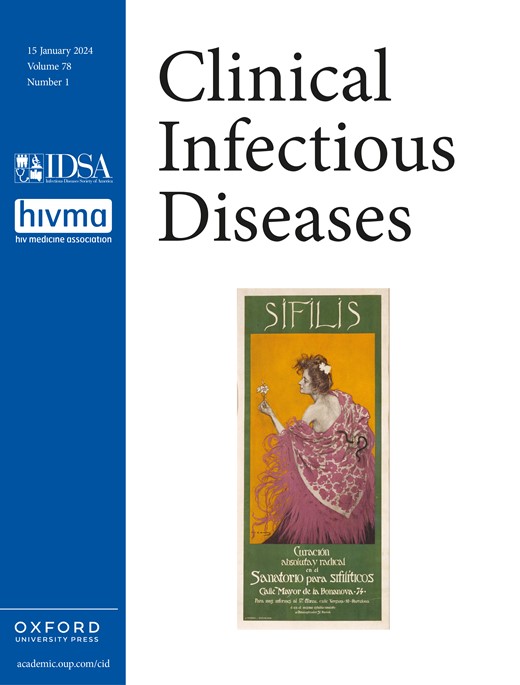Clinical features and outcomes of Human Herpesvirus-6 DNAemia in critically ill patients: a retrospective multicenter analysis
IF 8.2
1区 医学
Q1 IMMUNOLOGY
引用次数: 0
Abstract
Introduction Human Herpesvirus-6 (HHV-6) DNAemia is not rare in intensive care unit (ICU) patients. However, evidence for a causal association of HHV-6 DNAemia with organ disease and with mortality is limited in this setting. In ICU patients with HHV-6 DNAemia, we sought to 1) assess the prevalence of HHV-6 disease, 2) identify risk factors for HHV-6 disease and 3) investigate its association with mortality. Methods Retrospective multicenter case-matched study in three ICUs from January 2011 to January 2022 of patients with HHV-6 viral load in the whole blood (genome equivalent copies/106 cells) detected during the ICU stay. Results One hundred and sixty-eight patients were included. Seventeen (10%) were classified as HHV-6 disease (i.e., HHV-6 DNAemia with attributable end-organ disease) and 151 (90%) as HHV-6 reactivation (i.e., HHV-6 DNAemia without any attributable end-organ disease). Immunodepression was significantly more frequent in HHV-6 disease patients (100% vs. 48%, p < 0.001). Eleven (65%) HHV-6 disease patients received hematopoietic stem cell transplantation (HSCT). End-organ diseases were encephalitis (n = 10) and pneumonia (n = 7). The ICU mortality was 32% (n = 53). In multivariate analysis, HHV-6 disease remained independently associated with ICU (OR 4.90) and 90-day (HR 2.25) mortality. Mortality remained significantly higher in the HHV-6 disease group (OR 4.30) when compared to matched ICU patients without HHV-6 DNAemia. Conclusion Our analysis suggests that HHV-6 disease develops in 10% of patients with HHV-6 detection in the ICU, mostly in the setting of allogeneic HSCT and is independently associated with ICU and 90-day mortality.危重患者疱疹病毒-6型dna血症的临床特征和结局:一项回顾性多中心分析
人类疱疹病毒-6 (HHV-6) dna血症在重症监护病房(ICU)患者中并不罕见。然而,在这种情况下,HHV-6 dna血症与器官疾病和死亡率的因果关系的证据有限。在患有HHV-6 dna血症的ICU患者中,我们试图1)评估HHV-6疾病的患病率,2)确定HHV-6疾病的危险因素,3)调查其与死亡率的关系。方法对2011年1月至2022年1月3间ICU的全血HHV-6病毒载量(基因组当量拷贝/106个细胞)患者进行回顾性多中心病例匹配研究。结果共纳入168例患者。17例(10%)被归类为HHV-6疾病(即,HHV-6 dna血症伴终末器官疾病),151例(90%)被归类为HHV-6再激活(即,HHV-6 dna血症伴终末器官疾病)。免疫抑制在HHV-6疾病患者中更为常见(100% vs. 48%, p <;0.001)。11例(65%)HHV-6病患者接受了造血干细胞移植(HSCT)。终末器官疾病为脑炎(n = 10)和肺炎(n = 7), ICU病死率为32% (n = 53)。在多变量分析中,HHV-6疾病仍然与ICU (OR 4.90)和90天死亡率(HR 2.25)独立相关。与没有HHV-6 dna血症的匹配ICU患者相比,HHV-6疾病组的死亡率仍然明显更高(OR 4.30)。结论:我们的分析表明,在ICU中检测到HHV-6的患者中,有10%发生HHV-6疾病,主要发生在同种异体造血干细胞移植的患者中,并且与ICU和90天死亡率独立相关。
本文章由计算机程序翻译,如有差异,请以英文原文为准。
求助全文
约1分钟内获得全文
求助全文
来源期刊

Clinical Infectious Diseases
医学-传染病学
CiteScore
25.00
自引率
2.50%
发文量
900
审稿时长
3 months
期刊介绍:
Clinical Infectious Diseases (CID) is dedicated to publishing original research, reviews, guidelines, and perspectives with the potential to reshape clinical practice, providing clinicians with valuable insights for patient care. CID comprehensively addresses the clinical presentation, diagnosis, treatment, and prevention of a wide spectrum of infectious diseases. The journal places a high priority on the assessment of current and innovative treatments, microbiology, immunology, and policies, ensuring relevance to patient care in its commitment to advancing the field of infectious diseases.
 求助内容:
求助内容: 应助结果提醒方式:
应助结果提醒方式:


